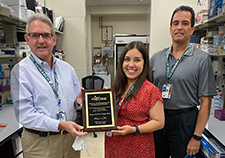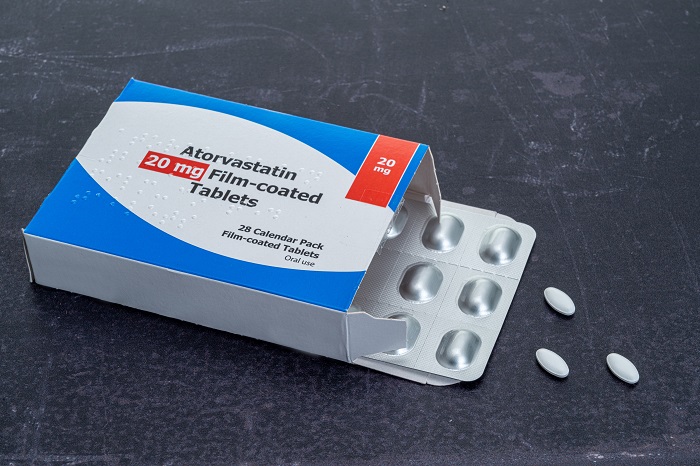Office of Research & Development |
 |


New research based on VA's Million Veteran Program backs existing nutritional advice to avoid deep-frying foods in favor of methods like pan-frying, baking, or grilling. (Photo:©iStock/brazzo)
March 30, 2020
Mike Richman
VA Research Communications
"Our findings provide evidence for a dose-dependent association between fried food consumption and incidence [of coronary artery disease]."
A growing body of research has linked fried foods to chronic health conditions, such as diabetes, heart attack, obesity, and hypertension. Surprisingly, however, the findings have been mixed on whether fried foods are associated with coronary artery disease.
Coronary arteries are the blood vessels that transport oxygenated blood to the heart. A narrowing or blockage of a coronary artery can lead to chest pain, shortness of breath, or heart attack.
Now, a large study that included data on more than 150,000 Veterans finds that risk of coronary artery disease—a form of heart disease—rises based on the rate of fried food consumption. Jackie Honerlaw, who led the study while affiliated with the Massachusetts Veterans Epidemiology Research and Information Center at the VA Boston Healthcare System, says it’s the largest paper to date on the link between fried foods and heart disease. The Veterans were enrolled in VA’s Million Veteran Program, which is aimed at learning how genes, lifestyle, and military exposures affect the health of former service members.
“Our findings provide evidence for a dose-dependent association between fried food consumption and incidence [of coronary artery disease],” the researchers write. “The MVP cohort provides an ethnically diverse sample of Veterans from across the nation with sufficient [cases] for analysis. While a randomized controlled trial is needed to confirm these results, this may not be feasible given the evidence of cardiovascular disease risk related to fried food consumption.” In other words, the researchers say it would be unethical to do a trial in which some participants eat a lot of fried foods, given what doctors already know about the harmful effects.
The study appeared online in the journal Clinical Nutrition in June 2019. Honerlaw didn’t find the main conclusion surprising because of a 2014 analysis that found eating fried food regularly is significantly associated with the risk of diabetes and moderately associated with coronary artery disease. The analysis, which appeared in the American Journal of Clinical Nutrition, pooled data from the Nurse’s Health Study and the Health Professionals Follow-Up Study.

VA Study Documents Health Risks for Burn Pit Exposures

VA center training the next generation of researchers in blood clots and inflammation

Could cholesterol medicine reduce dementia risk in seniors?

VA investigator brings diversity into autoimmune disease research
With a combined cohort of nearly 112,000 participants, the analysis represented the largest cohort on the connection between fried foods and heart disease before Honerlaw’s study was published, she says. The participants were free of cardiovascular disease, diabetes, and cancer at baseline.
On the main finding in Honerlaw’s study, American Heart Association (AHA) fellow Dr. Penny Kris-Etherton says: “It aligns with our current dietary recommendations, which say to typically use healthy food preparation techniques. There are many healthier ways to eat foods that are typically fried like french fries. It’s better to eat potatoes in other ways, like a plain baked potato or an oven-roasted potato, and to eat grilled chicken instead of fried chicken.”
Many Americans are frequent consumers of fried foods, such as french fries and fried chicken, which are both high in sodium, or salt. Too much salt can increase the risk of high blood pressure, stroke, heart disease, kidney disease, stomach cancer, and osteoporosis, a condition when bones become weak and brittle. The study didn’t control for the consumption of salt, so the conclusion doesn’t imply cause and effect, just an association. Plus, french fries and fried chicken are often rich in trans fats, which can raise bad (LDL) cholesterol levels and cause clogged or blocked arteries.
In addition, frying can raise the energy density of foods—basically, the calorie count—or the absorption of fats, and change the composition of nutrients. These factors can lead to obesity, elevated blood pressure, and diabetes.
There are several reasons, Honerlaw explains, that previous findings on fried foods and coronary artery disease have been mixed. For one, no large randomized trial has assessed the effects of fried foods on coronary artery disease, she says, noting that data are from observational studies can be prone to error.
“Differences in how the studies were conducted, errors in the self-reporting of fried foods, and drastic improvements over time in the treatment of patients with heart disease, among other reasons, can partly explain such inconsistency,” she says. “For example, differences in calories between deep and sautéed fried foods and the type of oil used for frying, as well as portion sizes, are sources of error and not standardized across studies.”
Plus, she says, some oils used for frying are less likely to lead to heart disease. A study of 41,000 adults in Spain who were followed for more than a decade found that fried foods were not linked to coronary artery disease or all-cause death. Olive oil, sunflower oil, and safflower oil, which are high in polyunsaturated fats, are often used for frying in Spain. Those fatty acids can help lower LDL cholesterol levels.
In the United States, on the other hand, the overall diet quality is “pretty bad,” AHA’s Kris-Etherton says: “We’re eating fried foods that are fried for longer periods of time in oils. I don’t think it’s just the type of fat. It’s also how long it’s fried, and how often the frying oil is used again and again, and then the rest of the diet, as well.”
In addition to the type of oil used, Honerlaw notes that many factors go into the frying process, including temperature fluctuations, the duration of frying, and the quantity of food. “None of the studies we reviewed were able to comment on those factors,” she says. “Thus, temperature could have contributed to the mixed results, but temperature alone is not the reason for studies having different results.”
If oils are used for frying at temperatures higher than recommended, they undergo unhealthy chemical changes.
Honerlaw and her team reviewed data in VA’s electronic health record and questionnaires completed by Million Veteran Program (MVP) volunteers. Of the 154,663 MVP enrollees with survey data on dietary habits, the average age was 64 and 90% were men. More than 800,000 Veterans have signed up for MVP to date, and enrollment continues.
“Diet-related information is not routinely collected during clinic visits and thus is not available in the general VA electronic medical record,” Honerlaw says. “This research was well-suited to be performed in the MVP cohort because many of the participants have completed a survey that asks about dietary habits, including fried food intake.”
In the study, the researchers established four categories based on frequency of consumption of fried foods. The rate of coronary artery disease increased with higher frequency. Among the 69,617 Veterans who ate fried food less than once per week, for example, 14.6% experienced coronary artery disease. The rates increased from there:
In a large national cohort of U.S. Veterans,” the researchers wrote, “fried food consumption has a positive, dose-dependent association” with coronary artery disease.
On the whole, during an average follow-up of about three years, there were more than 6,700 incidents of coronary artery disease in the cohort and nearly 7,000 cases of coronary artery disease and death.
The most common cooking oil used for frying at home was vegetable oil (72%), followed by butter (28%) and margarine (17%). Vegetable oils, which are edible oils extracted from plants, provide nutrients the body needs, such as essential fats and vitamins. But they may also contain trans fats that soak into food. Plus, high cooking temperatures used during frying can cause the trans fat content of the oil to increase.
In a secondary analysis, the researchers observed a stronger association between fried food and coronary artery disease among overweight and obese people, compared with Veterans with a normal body mass index, or weight-to-height ratio. However, the seriousness of the effect of fried foods on coronary artery disease was similar between those groups. The research team also found a link between fried food consumption and heart disease among Veterans with diabetes but did not observe a major association in those without diabetes.
Frequent consumers of fried food were mostly non-white and male. They also had lower education levels and were more likely to smoke. Honerlaw and her team controlled for age, sex, race, education, exercise, smoking, and alcohol consumption. “By adjusting for these factors, we did see some reduction in the association between fried food consumption and the risk of coronary artery disease,” Honerlaw says. “This was an important step to ensure accurate results because it takes into account the impact that these factors may have on the link between fried food and heart disease.”
Honerlaw says it’s unlikely her group’s findings will influence VA recommendations that urge Veterans to restrict their intake of fried foods.
“This is less likely since current dietary guidelines for Americans don’t include fried foods as a healthy habit, given existing knowledge about potential harms from fried foods,” she says. “Nonetheless, I think these results provide additional evidence to support potential harm to health that comes with fried foods.”
Kris-Etherton of the American Heart Association says the decision of how much fried food to eat, which oil to use in the frying process, and the length of cooking time is complicated if one is hoping to prevent health problems. She recommends that instead of frying food in olive oil, safflower oil, or sunflower oil, as is commonly done in Spain, Americans should simply choose healthier foods. She does, however, support the use of virgin olive oil and extra virgin olive oil, both of which are healthier than oils regularly used for frying, in salads that are loaded with vegetables.
“Something like pan fried fish, baked fish, or grilled fish is much, much, much healthier than all of these deep-fried foods,” she says. “The message you want to leave with people is that it’s not good to eat fried foods all the time.”
VA Research Currents archives || Sign up for VA Research updates